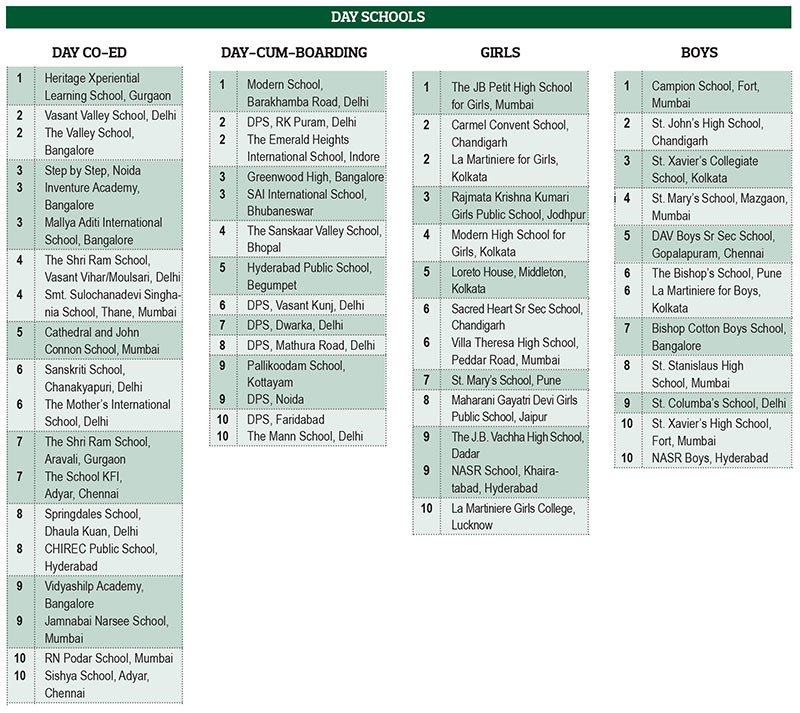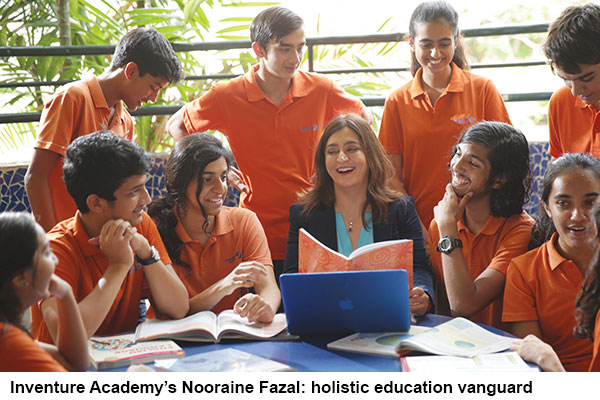Top 1000 – EW India school rankings 2019-20
To conduct the EW India School Rankings 2019-20 survey, 122 field personnel of the Delhi-based C fore interviewed 12,213 fees-paying parents, school principals, teachers and senior school students in 28 major cities and education hubs across India. This is the world’s most detailed schools rankings survey – Dilip Thakore & Summiya Yasmeen

Initiated in 2007, over the past 12 years the annual EducationWorld India School Rankings (EWISR) has matured into India’s — and the world’s — largest and most comprehensive survey of Top 2,000 primary-secondary schools divided into three broad categories — day, legacy boarding and international institutions.
 Initially, in our very first survey, all schools were ranked inter se without classification and produced distorted results. Therefore after a change of the rating and rankings agency from IMRB to the Delhi-based C fore (Centre for Forecasting & Research Pvt. Ltd), the unprecedented annual EWISR divided the country’s most well-known schools into the said broad categories for evaluation by a large number of knowledgeable stakeholders in education — school principals, teachers, educationists and fees-paying parents — who were designated sample respondents — reflecting a broad consensus of informed public opinion.
Initially, in our very first survey, all schools were ranked inter se without classification and produced distorted results. Therefore after a change of the rating and rankings agency from IMRB to the Delhi-based C fore (Centre for Forecasting & Research Pvt. Ltd), the unprecedented annual EWISR divided the country’s most well-known schools into the said broad categories for evaluation by a large number of knowledgeable stakeholders in education — school principals, teachers, educationists and fees-paying parents — who were designated sample respondents — reflecting a broad consensus of informed public opinion.
Subsequently in 2013, we further refined our broad day, boarding and international categories after receiving feedback from educators and teachers that the EWISR was comparing apples with oranges. Accepting this argument, each category was further sub-divided. Thus day schools were sub-divided into day co-ed, day-cum-boarding, boys and all-girls schools and ranked inter se in their distinctive sub-categories. This logic was also applied to boarding and international schools.
Moreover, unlike school rankings published in developed Western countries which rank schools on the single parameter of academic excellence, right from the start your editors insisted that the EWISR should rate and rank schools on several (currently 14) parameters including teacher competence, teacher welfare and development, institutional leadership, co-curricular, life skills and sports education, infrastructure etc, in addition to academic reputation.
This is because we firmly believe that there’s much more to children’s education experience than academic excellence and are fully convinced that the best schools provide holistic, balanced education which enables development of the multiple intelligences inherent in every child. Therefore unlike in the UK or several states in the US where schools are ranked, in the annual EWISR it’s perfectly feasible for a school which isn’t highly ranked in school-leaving exams to be top-ranked because of its management and faculty according equal importance to life skills, co-curricular and sports education. Indeed in the annual EWISR, academically excellent schools are seldom top-ranked.
 Consequently, the logic of assessing and evaluating schools on wider parameters of education excellence rather than just academic outcomes is widely accepted in India. Several education-focused publications such as Digital Learning, Education Today.com and ScooNews have ‘adopted’ our carefully conceptualised parameters of school education excellence. However, we have neither objected nor condemned them for plagiarism or passing off because we believe that in their own way, they are expanding the market for education products, media and services.
Consequently, the logic of assessing and evaluating schools on wider parameters of education excellence rather than just academic outcomes is widely accepted in India. Several education-focused publications such as Digital Learning, Education Today.com and ScooNews have ‘adopted’ our carefully conceptualised parameters of school education excellence. However, we have neither objected nor condemned them for plagiarism or passing off because we believe that in their own way, they are expanding the market for education products, media and services.
Nevertheless it’s important for the public to be aware of the critical difference between the annual EWISR survey and the rankings of other publications. As mentioned in passing, the annual EWISR survey and league tables rating and ranking the country’s Top 1,000 primary-secondary schools are the outcome of field interviews conducted countrywide by over 100 C fore personnel who persuade 12,000-plus sample respondents comprising a mix of reputed educationists, principals, teachers, fees-paying parents, and latterly, senior school students to rate short-listed (by EducationWorld) primary-secondaries on critical parameters of education excellence.
Over 3,500 knowledgeable sample respondents in four regions (north, south, east and west) are invited to rank sufficiently high-profile schools in their regions (on the premise that respondents are unlikely to be familiar with schools in distant parts of the country) on 14 parameters of school education excellence (teacher competence, teacher welfare and development, academic reputation, co-curricular education, sports education, individual attention to students, life skills and conflict management, infrastructure, value for money, leadership/management quality, parental involvement, internationalism, special needs education with boarding schools also rated under the parameters of pastoral care and safety & hygiene.
The scores awarded on a scale of 1-10 to schools by sample respondents under every parameter are multiplied by 10 (except teacher competence which is awarded double weightage) and totalled to rank schools inter se in each of the 14 categories. This elaborate exercise for which 122 C fore field researchers interviewed 12,213 sample respondents over a period of four months (April-July) necessitated deployment of substantial resources in terms of personnel, time and money.
 For this year’s perceptual survey, 122 C fore field researchers interviewed 4,340 educationists/principals/teachers and 7,597 SEC (socio-economic category) A fees-paying parents, plus class X-XII school students in 28 cities. Apart from the metros, we interviewed sample respondents in Hyderabad, Pune, Chandigarh, Jaipur, Lucknow, Kochi, Jammu, Bhopal, Bhubaneswar, Gurgaon and Noida among other major cities of India. Moreover, to rate and rank government and private budget schools, we also interviewed parents in SEC B, C and D categories. However low-profile, uncommunicative schools which were rated by less than 25 sample respondents have not been included in our league tables. I am confident this is the most comprehensive schools’ rating and ranking survey in Indian history and truly reflects informed knowledgeable public opinion,” says Premchand Palety, an alumnus of the Punjab Engineering College, Chandigarh and Fore School of Management, Delhi who acquired market research experience and expertise with ORG (Operations Research Group, Vadodara — India’s pioneer retail market research company) — for over a decade before he went solo and promoted C fore in 2000.
For this year’s perceptual survey, 122 C fore field researchers interviewed 4,340 educationists/principals/teachers and 7,597 SEC (socio-economic category) A fees-paying parents, plus class X-XII school students in 28 cities. Apart from the metros, we interviewed sample respondents in Hyderabad, Pune, Chandigarh, Jaipur, Lucknow, Kochi, Jammu, Bhopal, Bhubaneswar, Gurgaon and Noida among other major cities of India. Moreover, to rate and rank government and private budget schools, we also interviewed parents in SEC B, C and D categories. However low-profile, uncommunicative schools which were rated by less than 25 sample respondents have not been included in our league tables. I am confident this is the most comprehensive schools’ rating and ranking survey in Indian history and truly reflects informed knowledgeable public opinion,” says Premchand Palety, an alumnus of the Punjab Engineering College, Chandigarh and Fore School of Management, Delhi who acquired market research experience and expertise with ORG (Operations Research Group, Vadodara — India’s pioneer retail market research company) — for over a decade before he went solo and promoted C fore in 2000.
Ab initio, publication of the annual EWISR league tables which are received with great enthusiasm by stakeholders in K-12 education, were followed up with the EWISR Awards, a big ticket annual event staged in the national capital at which schools ranked among the Top 10 in the country, states and cities are awarded and celebrated. The EWISR Nite (now a two-day and one night event) attracts over 1,000 promoters, principals and/or senior teachers from across the country and is arguably the world’s largest felicitation conclave of school leaders. At this annual event, school leaders not only receive awards but also participate in lectures and debate ways and means to raise academic standards in primary-secondary education to global norms.
An inevitable fallout of the success of the annual EWISR league tables and consequential EW India School Rankings Awards, is that several publications have also begun to issue their own school rankings. Likewise, they also celebrate and award their top-ranked schools with pomp and assurance. While we don’t mind their imitative initiatives, we are somewhat surprised that some of the country’s leading educationists and school leaders naively accord rankings of rival publications based upon the verdicts of hastily assembled, regionally unbalanced juries working behind closed doors, equivalence with our elaborate field-based, nationwide annual surveys. We request school leaders and parent communities to bear in mind that because of the substantially greater time, money and human resources invested in the annual EducationWorld India School Rankings, our ratings and ranking methodology is more robust, and our league tables have greater credibility.
With this caveat, we present the EWISR 2019-20 league tables rating and ranking India’s Top 1,000 primary-secondary schools ranked separately in the day co-ed, day-cum-boarding, day boys and all-girls; boarding co-ed, boys and girls schools; and international day, day-cum-boarding and fully residential schools (countrywide, in the 28 states and over 250 cities) in the pages following.
Moreover, top-ranked day, boarding and international (across all sub-categories) schools are separately ranked under 14 parameters of education excellence. As stated earlier, this is the most detailed and comprehensive schools survey worldwide. It will help parents choose the most suitable school for their children, and also aid and enable school leaders and teachers to conduct thorough SWOT (strengths, weaknesses, opportunities and threats) analyses for continuous institutional improvement.
https://www.educationworld.in/school-ranking/

















Add comment